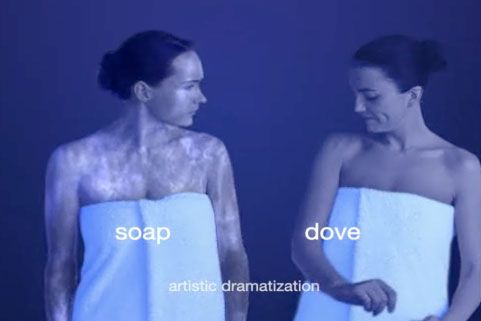Soap vs. Dove - We lose?

Soap vs Detergent?
Doves new ad campaign makes soap users uncertain of soap scum.
First of all, don't PANIC.
Second, soap scum is formed by mineral in tap water combined with soap. With hard water you have more soap scum than with soft water. If water is "hard" it mainly contains chlorides, sulphates, phosphates and bicarbonates.
Traditional soaps are composed mainly of potassium and sodium salts of fatty acids. The hardness ions react with the fatty acids and give insoluble compounds. Due to the effect of the still dissolved soap, the insoluble compounds end up in the foam and build the scum. It's unlikely to have soap scum on your skin if you shower off the soap. Of course if you apply soap and leave the foam on it will look like in the commercial or the picture above.
As it says on Unilever's website and small prints " *artistic dramatisation of soap scum in hard water."
Anyhow, the ingredients and environmental consequences explain themselves.
- DISTILLED WATER
- SODIUM HYDROXIDE
- COCONUT OIL
- HEMPSEED OIL
- OLIVE OIL
- PALM OIL
- MICHELIA ALBA LEAF
- CABREUVA
- CLEMENTINE
- LITSEA CUBEBA
- HOWOOD
- FRENCH CLAY
- SODIUM LAUROYL ISETHIONATE
- STEARIC ACID
- SODIUM TALLOWATE (SAPONIFIED RENDERED ANIMAL FAT) or SODIUM
- PALMITATE
- LAURIC ACID
- SODIUM ISETHIONATE
- SODIUM STEARATE
- COCAMIDOPROPYL BETAINE
- SODIUM COCOATE or SODIUM PALM KERNELATE
- FRAGRANCE
- SODIUM CHLORIDE
- TETRASODIUM EDTA
- TETRASODIUM ETIDRONATE
- TITANIUM DIOXIDE (CI 77891)
- WATER
Unilever is not the only one to blame, but it is one of the biggest manufacturer in the world who could do a difference but chooses not to. See Change.










